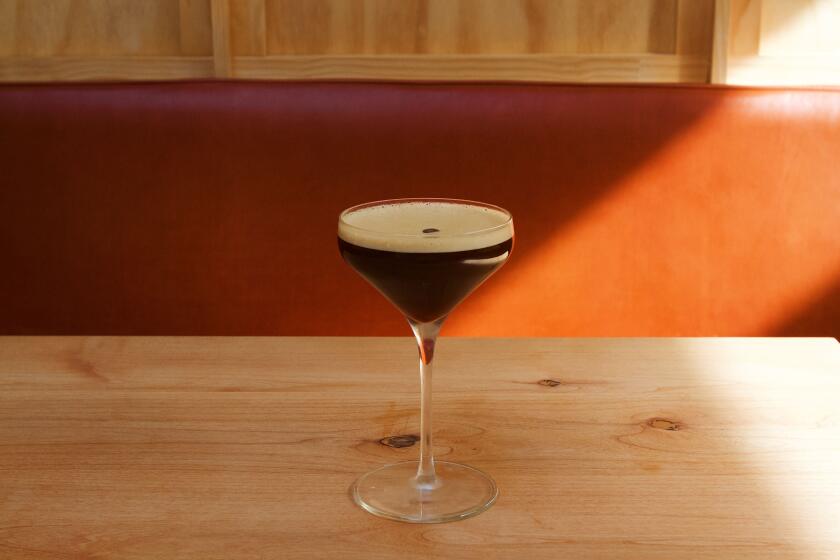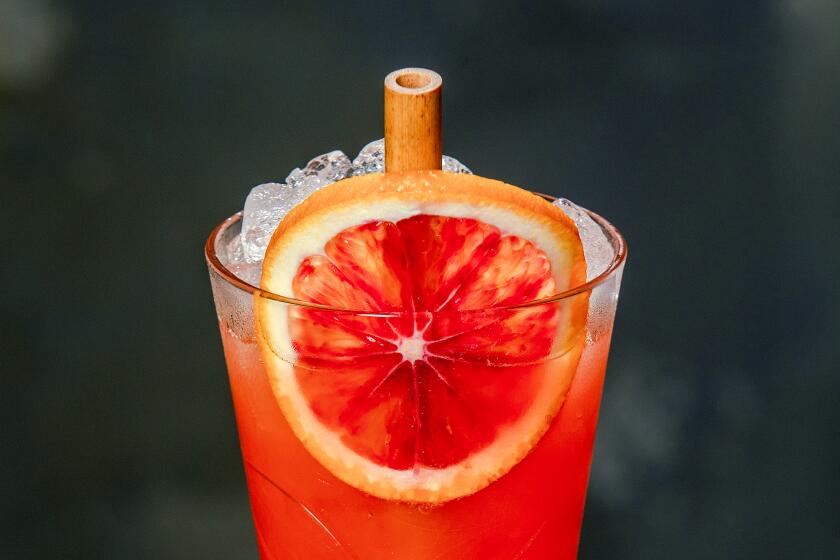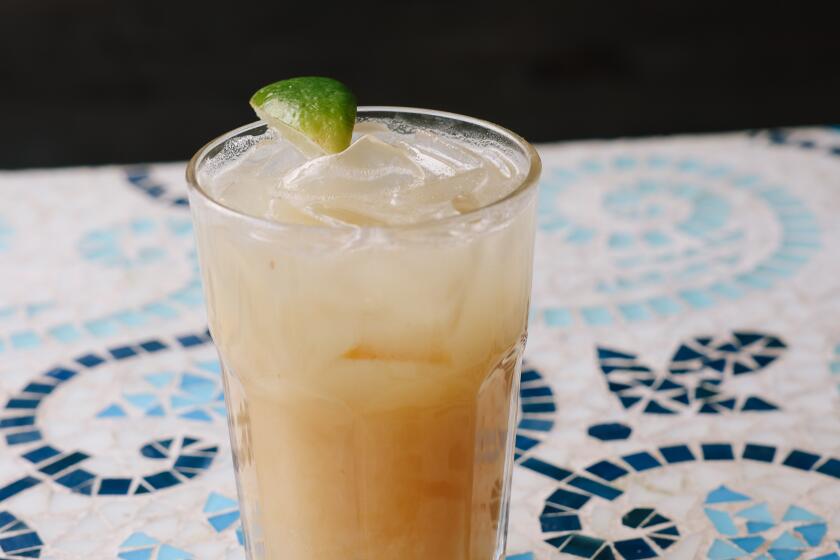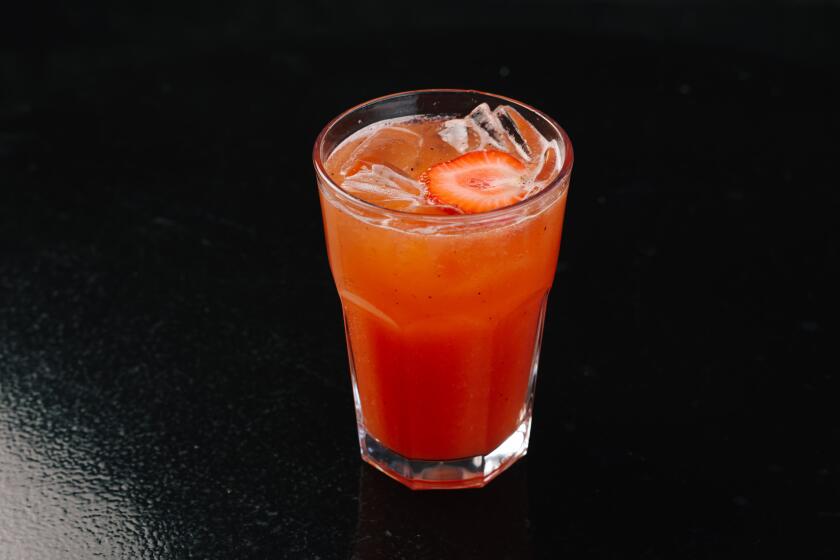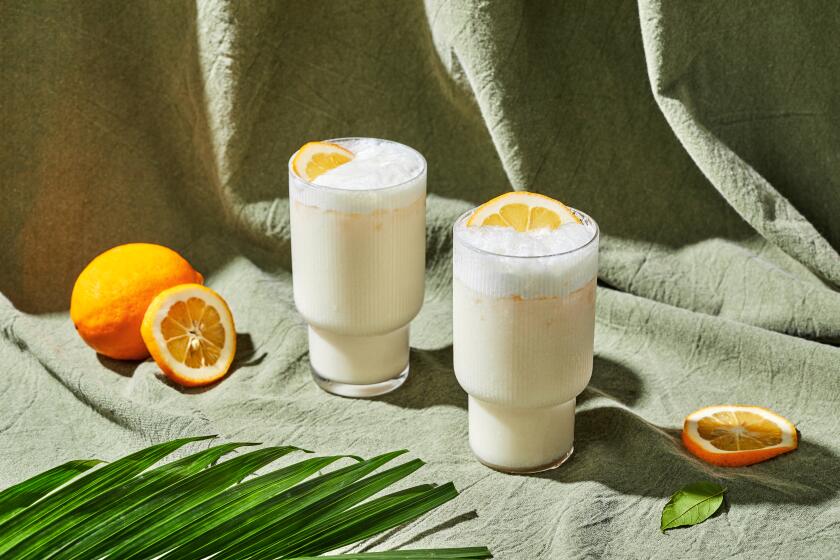Cucumber-Lime Agua Fresca
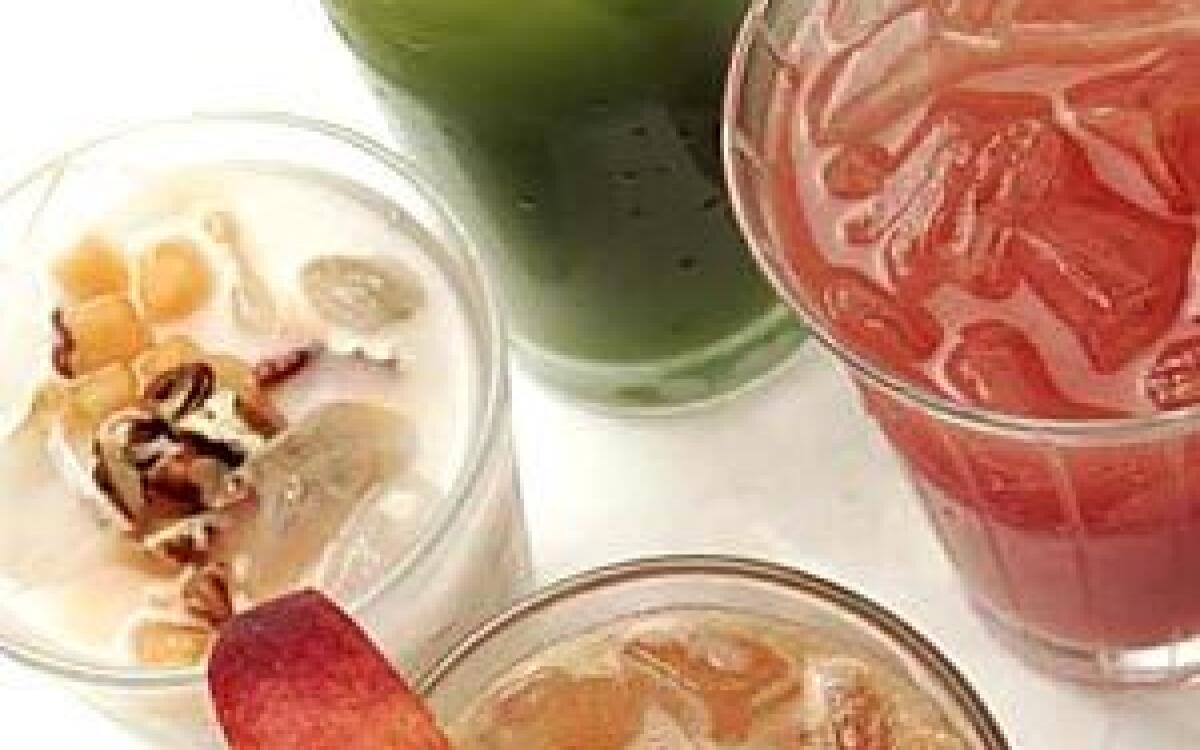
- Share via
On counters of neighborhood taquerias and Oaxacan restaurants, at Salvadoran farmers market stands and Eastside backyard parties, even at swank Hollywood restaurants, you can see the huge glass vitroleros, beehive-shaped jars filled with aguas frescas in a spectrum of stunning colors. Each flavor is like a point of reference on a color wheel: the deep magenta of jamaica (a variety of hibiscus flower), the pale green of honeydew melon or cucumber-lime, the scarlet of just-made sandia (watermelon), rice-based horchata’s milky white.
Aguas frescas have a long tradition in Mexico and Latin America, where the “fresh waters” -- made with fresh fruit or rice, tamarind pods or dried hibiscus flowers, sugar and water -- are the perfect thirst-quencher for hot weather and sometimes-hotter cuisine. In the pre-Columbian 15th century, the story goes, Aztec farmers would paddle their canoes into Tenochtitlan (now Mexico City) with fresh fruit that they would mash and mix with water for a refreshing drink.
Just what’s in the gorgeous, ice-loaded jars depends on what fruit is in season. Right now, you might find cantaloupe, a pretty watermelon laced with lime, maybe a pale honeydew melon or peach, or a combination of more than one fruit. Year-round, you’ll usually find the classic trinity of aguas frescas not made with fruit: tamarindo, horchata and jamaica.
These are neither sodas nor fruit juices, but subtly flavored drinks that are balanced, light-bodied -- and not overly sweet.
Southern California’s best aguas frescas makers, traditionalists and modernists alike, rely on the little touches, either personal or regional. An agua fresca is a minimalist’s drink: With so few components, the quality of the ingredients and the simple twists (a squeeze of lime, a shot of agave nectar) make all the difference.
Juan Antonio, owner of the cafe Oaxacalifornia in downtown Los Angeles, uses his grandmother’s recipe for horchata, which many people consider the most refreshing agua fresca. Horchata is made by soaking rice overnight in water, then pureeing the mixture in a blender, straining it and adding flavorings such as cinnamon, vanilla or almonds.
Antonio serves the drink over ice with a sprinkle of diced toasted pecans and fresh cantaloupe -- topped with a scoop of his house-made cactus pear sorbet. The sorbet slowly melts in the glass, painting the pale horchata in pink and orange hues, and adding a terrific flavor counterpoint. He also likes to add a scoop of lime sorbet to a glass of tamarindo or, when he’s made a jar, a chilacayota agua fresca. (Chilacayota is a Mexican squash.) Using the sorbet, Antonio says, “is a typical way of serving [aguas frescas] in Oaxaca.”
Traditional tamarindo -- made by boiling, soaking and straining tamarind pods, with water and a little sugar -- can also be jazzed up.
Near USC, at the busy taqueria La Taquiza, Anthony Medina adds pints of fresh strawberries to his jamaica agua fresca (also a family recipe), first steeping hibiscus flowers to make tea, then blending it with berries and a little sugar.
The resulting drink is stunningly pretty -- a crimson so rich it might have spilled from a Frida Kahlo painting -- and has a flavor that perfectly juxtaposes the tart hibiscus with the sweet, floral notes of the berries.
“You have to counterbalance the high acidity of the hibiscus,” says Medina, who remembers his mother making the drinks when he was a kid. He likes guava too, and mango, which he blends with a little lime.
Over at the Hollywood restaurant the Hungry Cat, bartenders take their aguas frescas as seriously as their cocktails -- a plus for kids and non-drinkers -- and if you sit at the bar, you can watch as your agua fresca is created. Aguas frescas aren’t on the bar menu, but offered as daily specials. A peach agua fresca is sweetened with lavender-infused simple syrup. Another Hungry Cat favorite is a cucumber-lime, and before cherry season ends, look for a Bing cherry agua fresca, spiked with lemon and Fresno chile-infused simple syrup.
Aguas frescas shouldn’t have a lot of sugar -- they’re refreshing thirst-quenchers, not sweet drinks -- so it’s key to use the sweetener judiciously and to make sure it’s fully dissolved. And, depending on what kind of fruit you’re using, macerating the fruit can also work wonders. Macerating -- tossing cut-up berries, for example, with sugar and allowing them to sit for half an hour -- brings out the fruit juices, accentuates the flavors and dissolves the sugar, all at the same time.
Sweetening the aguas, says Ivan Calderon, co-owner with his brother Marco of the Taco Mesa and Taco Rosa restaurants (in Costa Mesa, Orange, Ladera Ranch, Mission Viejo, Newport Beach and Irvine), “enhances the flavor of the fruit; it does the same thing that salt does to food.” But he suggests using agave nectar instead of sugar, as he does with all his restaurants’ aguas frescas. The nectar (available at Trader Joe’s stores, Whole Foods, Ralphs and other grocery stores), is less cloying than sugar and more healthful (higher in fructose, lower in glucose than sugar), and it dissolves instantly.
If you don’t have agave syrup on hand, take a tip from bartenders and make a quick simple syrup by briefly boiling equal parts sugar and water in a pan. You can flavor the simple syrup with lavender, as the folks at the Hungry Cat do, or with other herbs or spices (a trick used by pastry chefs as well as bartenders).
Use ripe fruit for aguas frescas, even fruit that’s slightly past its prime. You’re throwing it in the blender, after all, and you want the sweet rich notes of the fruit rather than its perfect appearance.
At his two Loteria Grills, the original at the Farmers Market on Fairfax and the newly opened restaurant in Hollywood, chef-owner Jimmy Shaw -- born and raised in Mexico City -- prominently displays the glass vitroleros.
Shaw combines a traditionalist’s approach and a chef’s creative flair when making his aguas. He’s outfitted his classic jars with spigots; he spikes his cucumber-lime agua with Serrano chile and a little salt. On a recent night behind the stoves of his new kitchen, Shaw shared a favorite trick. Make two batches of your favorite agua, he suggests, and freeze one batch in ice cube trays to use when serving. The agua fresca cubes won’t dilute the drink.
Improvisation (“Mexico is a land of masking tape and wire,” Shaw says) is as key an element as seasonality when making aguas frescas, so use whatever fruit you have handy. A ripe pineapple or papaya, a few pints of blackberries.
Then blend and balance out the flavors with a little sweetener, maybe some lemon or lime. Take the edge off your summertime thirst by tasting your agua as you make it.
In a blender, in batches, puree the cucumbers with 2 1/4 cups of water, the lime juice, chile, agave syrup and a generous pinch of sea salt on high speed. Strain through a fine-mesh strainer lined with a triple layer of cheesecloth (or use a chinois), discarding the solids. Serve over ice. Keeps 2 days, refrigerated.
Get our Cooking newsletter.
Your roundup of inspiring recipes and kitchen tricks.
You may occasionally receive promotional content from the Los Angeles Times.











